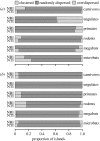Global patterns in the phylogenetic structure of island mammal assemblages
- PMID: 18397866
- PMCID: PMC2602667
- DOI: 10.1098/rspb.2008.0262
Global patterns in the phylogenetic structure of island mammal assemblages
Abstract
Assemblage-level phylogenies carry the signature of ecological and evolutionary processes, which may provide useful information on modes of assemblage formation. We present a global-scale analysis of the emergent phylogenetic properties of mammal assemblages on islands, in which we compared the structure of 595 island assemblages with null models constructed under four alternative definitions of regional source pools. Although most assemblages had a structure indistinguishable from random samples, for some mammal taxa, up to 40% of island assemblages were phylogenetically overdispersed. This suggests that in at least some cases, the processes that shape island faunas are not independent of phylogeny. Furthermore, measures of phylogenetic structure were associated in some cases with island geographical features (size, maximum elevation and habitat diversity). Our results suggest that part of the signal of assemblage formation processes is detectable in the phylogenies of contemporary island mammal faunas, though much is obscured by the complexity of these processes.
Figures


References
-
- Anderson T.M, Lachance M.A, Starmer W.T. The relationship of phylogeny to community structure: the cactus yeast community. Am. Nat. 2004;164:709–721. doi:10.1086/425372 - DOI - PubMed
-
- Bininda-Emonds O.R.P, et al. The delayed rise of present-day mammals. Nature. 2007;446:507–512. doi:10.1038/nature05634 - DOI - PubMed
-
- Blondel J, Vigne J.-D. Space, time and man as determinants of diversity of birds and mammals in the Mediterranean region. In: Ricklefs R.E, Schluter D, editors. Species diversity in ecological communities. University of Chicago Press; Chicago, IL: 1993. pp. 135–146.
-
- Brooks D.R, McLennan D.A. Historical ecology: examining phylogenetic components of community evolution. In: Ricklefs R.E, Schluter D, editors. Species diversity in ecological communities. University of Chicago Press; Chicago, IL: 1993. pp. 267–280.
-
- Brown J.H, Lomolino M.V. Sinauer Associates; Sunderland, MA: 1998. Biogeography.
Publication types
MeSH terms
LinkOut - more resources
Full Text Sources

